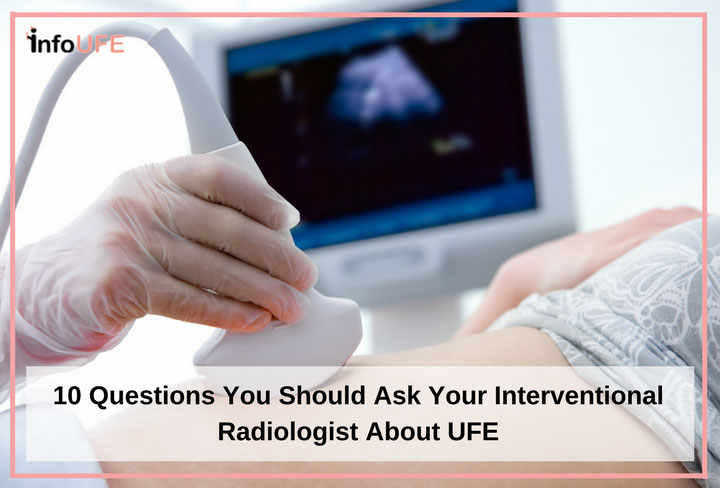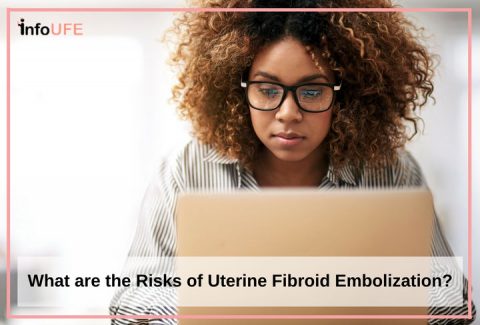
Are you ready to visit a doctor to discuss whether uterine fibroid embolization (UFE) may be a good treatment option for your uterine fibroids? If you’re like most women, you’ve probably done some research to prepare for your visit. Perhaps you’ve read up on the procedure and you’re wondering “What is interventional radiology?” or maybe you’re hoping to find out more about “What is uterine fibroid embolization?”
RELATED: Where Do I Turn If I Have Uterine Fibroids?
Interventional radiology is a sub-specialty of radiology that involves performing procedures using x-ray technology to diagnose and treat diseases without major surgery. Interventional radiologists are medical doctors who perform minimally invasive procedures, including uterine fibroid embolization (UFE) to treat uterine fibroids. During the UFE procedure, the interventional radiologist will place small beads into the blood vessels that carry blood and oxygen to the fibroids, cutting off the blood supply to the uterine fibroids, which usually results in the fibroids getting smaller.[i]
If you’re ready to find an Interventional Radiologist and discuss UFE as a possible treatment for your uterine fibroids, you’ll want to be prepared at your consultation. Because it’s not uncommon to be a little nervous when you go, some women find it helpful to have a list of questions at their first visit. You probably have a ton of questions, but there are a handful you should be sure to ask prior to having any procedure.
These questions have been adapted from the Agency for Healthcare Research and Quality’s “Quick Tips – When Planning for Surgery”.[ii]
Questions to Ask Your Interventional Radiologist
- Why Do I Need UFE? – Not all women with fibroids will need treatment, and even among the women who do need treatment, not all will be candidates for UFE. Make sure you ask and understand why UFE is being recommended for the treatment of your fibroids.
- Are There Alternatives to UFE? – You may have already considered all of the alternatives, but it’s still important to review all your options with a doctor and consider the risks and benefits of each.
- What Will Happen to My Fibroid Symptoms if I Don’t Have UFE? – You should know what will likely happen if you do nothing. The answer to this will vary because fibroids cause different symptoms in different women. For many women, without treatment, the symptoms will persist until menopause, and it is difficult to predict when that will be.
- What Are the Benefits of UFE? – You may have learned a lot in your own research on UFE, but it’s best to hear an expert’s view of the benefits of UFE. You should also ask what UFE can do to relieve your symptoms, and what it won’t do. Be sure to ask about when you can expect any improvement in your symptoms.
- What Are the Risks of UFE? – Like any procedure, UFE does have some risk. Being aware of the risks will help you in your decision. Be sure to ask about typical complications, how often they occur, and how they are handled when they come up.
- What Type of Anesthesia Will I Receive? – You should understand what medications are typically used to keep patients calm and pain-free during the UFE procedure. Usually, the sedation for UFE involves intravenous medications for anxiety and pain. You’ll want to be sure to mention if you have any known allergies to medications or anesthesia.
- Where Will the UFE Procedure Be Performed? – UFE can be performed in a state-of-the-art outpatient center. For complex medical conditions, some women may need to have the procedure performed in the hospital and need to stay overnight for monitoring.
- What Has Been Your Experience With UFE? – Knowing the interventional radiologist’s past experience is important. The number of UFE procedures that have been performed is important, but also ask about the success of the procedures and the major complications that occurred.
- How Will You Minimize My Exposure to X-rays? – The exposure to radiation, through x-rays, is an inescapable fact of having UFE. Any interventional radiologist should be able to describe the techniques that are used to minimize this exposure.
- What Will My UFE Recovery Be Like and How Long Will it Take? – You will want to make sure your expectations of recovery match what the doctor expects to happen. Typical recovery time for UFE is 8-14 days compared to hysterectomy, which can take 6 weeks. Ask your physician about any typical symptoms you may experience during recovery, including intermittent cramping and/or flu-like symptoms including possible fever and nausea. Your physician should schedule a follow up visit post procedure.
Feeling prepared to discuss UFE with your interventional radiologist can help eliminate at least some of the stress you may be feeling. Before you proceed with having UFE, you should have a solid understanding of why UFE is recommended for the treatment of your uterine fibroids and what the expected benefits and risks are.
Sources:
[i] Torre, A., et al., Uterine artery embolization for severe symptomatic fibroids: effects on fertility and symptoms. Hum Reprod, 2014. 29(3): p. 490-501.
[ii] AHRQ Archive, Quick tips – When Planning for Surgery. http://archive.ahrq.gov/patients-consumers/diagnosis-treatment/surgery/tips/tipsurgery.html


